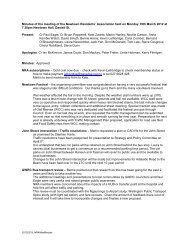Draft Town Belt Management Plan - Wellington City Council
Draft Town Belt Management Plan - Wellington City Council
Draft Town Belt Management Plan - Wellington City Council
Create successful ePaper yourself
Turn your PDF publications into a flip-book with our unique Google optimized e-Paper software.
Signed in my presence, having been previously translated this 11/10/52<br />
H. T. Kemp Native Secretary<br />
S. E. Grimestone, Chief Clerk Colonial Secretary’s Office 60<br />
While Māori sold this land on 11 October, on 27 October Governor Grey issued a Crown Grant to<br />
the Superintendent of the Wesleyan missions, Reverend James Watkin, for the establishment of a<br />
school. No school was forthcoming and the estate was transferred to the Provincial Government 61 .<br />
The demise of the pā in <strong>Wellington</strong> and Māori cease to use the <strong>Town</strong> <strong>Belt</strong> areas for<br />
gardening: The pressure from the growing town of <strong>Wellington</strong> and factors such as the wars in<br />
Taranaki saw the rapid decrease in the Māori population. Use of the large gardens also decreased<br />
rapidly. This often meant the land was leased out to Europeans wanting to farm the land largely for<br />
stock grazing.<br />
In 1850 Te Aro Pā had 186 inhabitants of Taranaki and Ngāti Ruanui descent. However by the mid-<br />
1850s, the Wesleyan mission near the pā noted that only “a small remnant of a once considerable<br />
tribe occupy a few miserable huts not far from the Mission House”. Many Māori went back to<br />
Taranaki with the altercations at Parihaka in the 1880s. Having moved back, the door closed<br />
behind them and they were unable to return to <strong>Wellington</strong> to reclaim their interests. The need for<br />
the difficult gardens on the hill quickly diminished.<br />
Tamati Wiremu Te Wera and his wife Te Awhitu Te Wera<br />
were some of the last residents at Te Aro in 1900.<br />
It was much the same story for Pipitea Pā and the gardens on Ahumairangi. The pressure on<br />
Pipitea Pā came from the arrival of European settlers from Petone. Māori moved out to the Hutt<br />
Valley where land remained and where the pressure of colonisation was less. Some also went back<br />
to Taranaki and their gardens too soon diminished. Gradually Māori disappeared from the streets<br />
of <strong>Wellington</strong> 62 .<br />
Kumutoto was no exception and, after being the centre of the flax trade in the early period of<br />
colonisation, it quickly succumbed to European urban pressure. When the people moved out the<br />
gardens –and their churches – were leased to Europeans.<br />
60 2 Deed 157 and 1 Deed 306<br />
61 1879 AJHR H-1 p60, testimony of Alexander Reid to the Royal Commission on Education Trusts.<br />
62 David Hamer, <strong>Wellington</strong> on the Urban Frontier, in The Making of <strong>Wellington</strong> 1800 – 1914, 1990, p231<br />
<strong>Draft</strong> <strong>Town</strong> <strong>Belt</strong> <strong>Management</strong> <strong>Plan</strong> October 2012 197





